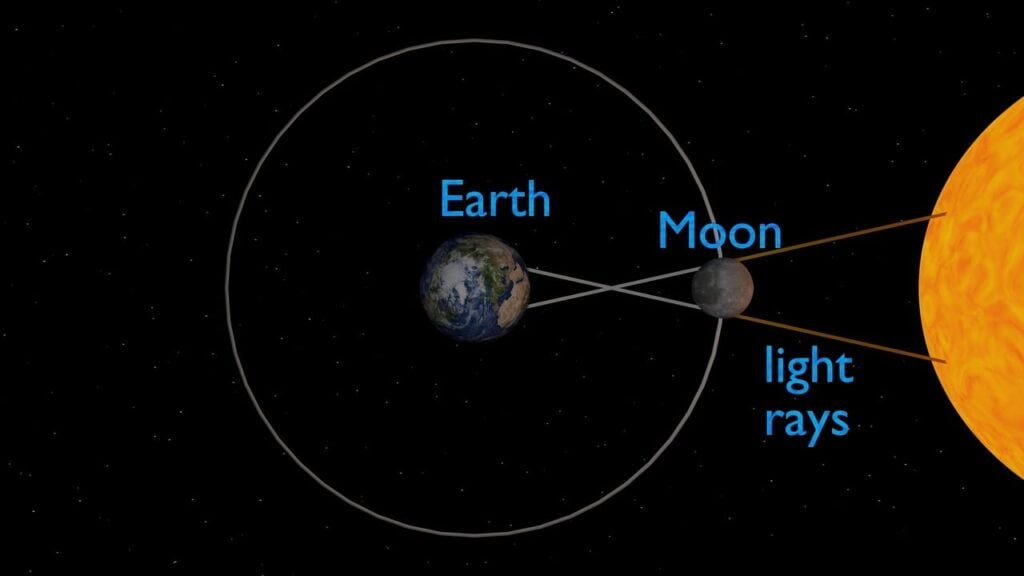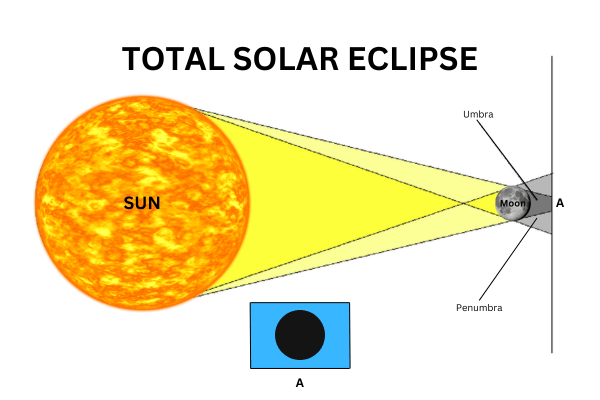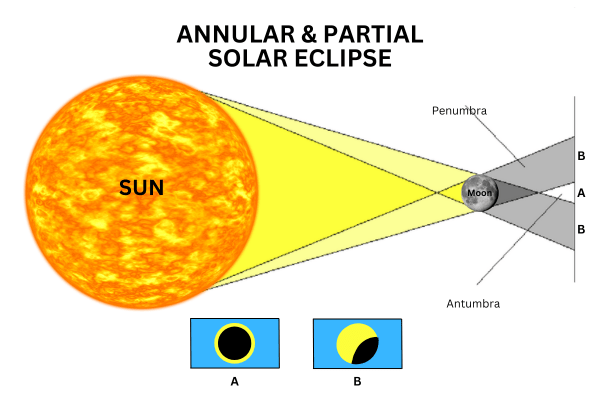
SHORT INTRODUCTION ABOUT SOLAR ECLIPSE
In our previous blog we discussed solar eclipse in detail. So here we will discuss in detail about different types of solar eclipse. In general, we know that a solar eclipse happens when the moon passes between the Earth and the Sun, blocking all or some of sun’s light. The celestial event can be classified in total, partial, or annular, depending on their alignment and distance of the Moon from the Earth. Solar eclipses provide a unique opportunity for scientific observation and public excitement since they can be remarkably beautiful and rare.
Total solar eclipses happen somewhere on earth about every 18 months, but they only happen in a particular place once every 375 years on average.
TYPES OF SOLAR ECLIPSES
As we told you earlier, the Solar eclipse happens when Earth-Moon-Sun are in a straight line or the same plane. Depending on how the moon passes between the sun and the earth, in general there are four types of solar eclipse—
- Total Solar Eclipse
- Annular Solar Eclipse
- Partial Solar Eclipse
- Hybrid Solar Eclipse
TOTAL SOLAR ECLIPSE

A total solar eclipse is a kind of solar eclipse that happens when the moon passes between the sun and earth by completely blocking the face of the sun. It is among one the four types of solar eclipse. This occurs during a New the sun’s light is completely blocked when the moon casts its shadow of across Earth, temporarily bringing about darkness. The duration of this completeness is depending upon the precise alignment and location, ranging from a few seconds to many minutes. The sun’s outer atmosphere, known as corona, which is often covered by its intense light, is feasible to observer during this time. It may be a chilling and stunning experience as the sky gets much darker and that temperature drops. Since total solar eclipse are very rare for any given place, both scientists and sky watchers are eagerly a weight this rare occurrence.
ANNULAR SOLAR ECLIPSE

An annular solar eclipse is a type of solar eclipse that happens when the moon passes between the sun and earth but when it is at its farthest point from Earth. Since in these types of solar eclipse the moon is farthest away from Earth, it appears smaller than the sun. As a result, it’s not able to completely cover the sun. During an annular solar eclipse, the Moon appears as a black disc above a bigger, brighter disc, forming a ring around the Moon. This phenomenon is often referred to as a “ring of fire”. Because of the Moon’s elliptical orbit around the earth, which causes variation in their distance from one another, this event occurs. The moon appears smaller in the sky and is unable to completely cover the Solar disc when it is getting close to its apogee, farthest point from. A partial Solar eclipse is visible to observers outside of the path of annularity, which is a small track on Earth where the eclipse is seen in all of its ring-like splendour.
PARTIAL SOLAR ECLIPSE
A partial solar eclipse happens when the moon passes between the sun and earth, but in this type of solar eclipse, the Sun, Moon, and Earth aren’t perfectly lined up. As a result, a smaller part of the Sun is visible, whereas the blocked part appears dark. During a complete or ring-shaped solar eclipse, individuals located outside the region enclosed by the Moon’s inner shadow observe a partial solar eclipse. This form of eclipse is visible from regions outside the path of totality, where the alignment is less precise. A partial solar eclipse causes the sky to dim slightly, but not significantly, as a total eclipse does. It is critical to utilize adequate eye protection, such as solar viewing glasses, to properly see the event, as gazing directly at the Sun can cause serious eye damage. Partial solar eclipses are more common than total eclipses, providing more opportunity to witness them. However, the degree of Sun coverage and visibility is determined by the observer’s location on Earth in relation to the eclipse’s path.
HYBRID SOLAR ECLIPSE

A hybrid eclipse is the rarest among all other types of solar eclipses because it transitions between a total eclipse and an annular eclipse. The apparent diameter of moon during a hybrid Solar eclipse is about equal to or some hot greater than the sun’s, creating different viewpoints based on the observer’s location. At certain points along with the eclipse’s path, the moon completely covers the sun, known as total eclipse. In other places, annular eclipse occurs when the moons shadow partially envelopes the sun, allowing a ring of the Sun to be seen around the Moon’s dark outline. This variation arises from the Moon’s shadow’s fluctuating coverage due to the earth’s curvature and the unique geometry of the eclipse path. Unlike other forms of solar eclipses, hybrid eclipse is a less common and offer a rare chance to witness the significant changes in the sun’s appearance from various viewpoints.



